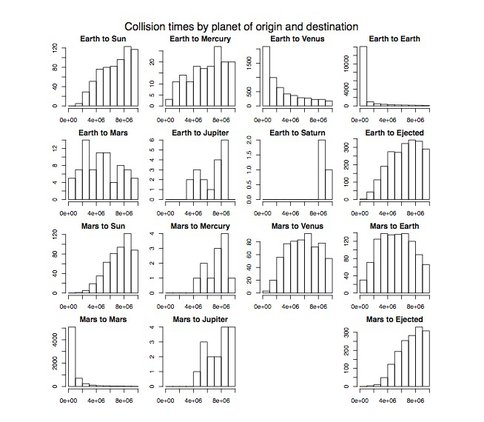2012 Annual Science Report
 Pennsylvania State University
Reporting | SEP 2011 – AUG 2012
Pennsylvania State University
Reporting | SEP 2011 – AUG 2012
Biosignatures in Extraterrestrial Settings
Project Summary
Exploring the prospects for biosignatures in extraterrestrial settings is a multi
Project Progress
4.1.1 Research by Kasting and collaborators shows H2 may explain early warm Mars. Collaboration with VPL and collaborator Haqq-Misra, and graduate student Ramirez.
4.1.2 Continued research by Ohmoto and collaborators of early CH4 in the atmosphere of terrestrial planets and role of volcanoes in CO2 outgassing. Details now reported in “Biosignatures in Ancient Rocks”
4.2 Progress by Lyons and collaborators continued of 17O/18O fractionation due to CO2 self-shielding during photolysis. Work underway on N2 and role of H2. Details now reported in “Biosignatures in Ancient Rocks”
4.3 Sigurdsson and collaborators in the Center for Exoplanets and Habitable Worlds continued research on extrasolar planets: graduate student Rachel Worth continued project on radial transport in the solar system in collaboration with Sigurdsson and House. Pathfinder near infrared spectrograph operated at HET telescope, U-Ne calibration for near IR and implementation of NIST supplied lasercomb operated and cross-calibrated.
Some highlights include:
PSARC supported 3 astronomy graduate students wholly or in part in 2011-12, working with several associated faculty, including new junior faculty, as part of an effort to sustain the astrobiology effort.
The habitable zone planet finder near-infrared spectrograph was funded by a National Science Foundation Major Research Instrumentation grant (PI Mahadevan PSU), leveraging off the pathfinder instrument funded in part by NAI. New calibration techniques using U-Ne lamps and an infrared laser frequency comb continued to be tested and used on science targets. NAI provided additional funding for engineering development of the spectrograph.
Graduate student Matthew Route, in collaboration with Prof. Wolszczan, did radio observations to find sub-stellar companions to nearby stars, and graduate student Sara Gettel finished her PhD thesis long term monitoring of bright giant stars, looking for long period exoplanets.
Prof. Wright continued ongoing observations of exoplanets and looking for new exoplanets, using radial velocity monitoring, and started a new project on early Solar System formation. Prof. Wright continued work on the Exoplanets catalog http://exoplanets.org/ Prof. Wright started a new collaborative project with Prof. Johnson (CIT) to find low mass planets around nearby bright stars using a dedicated telescope to be built in 2012-13.
Profs. Wright and Sigurdsson started a new project exploring anomalous mid-infrared sources and implications for habitability, leading to a new research project funded by the New Frontiers in Astronomy and Cosmology program, to start in 2012-13.
Graduate student Arpita Roy worked on a novel theoretical project studying aspects of early lunar formation.
Graduate student Rachel Worth continued modeling of transport of meteorite ejecta in the Solar System in collaboration with Profs House and Sigurdsson, using, in part, NAI Hawaii computing facilities. Research on early Solar System dynamical evolution continued.
A large group of PSARC collaborators used the new spectrographic techniques to independently confirm the existence of the circumbinary planet Kepler-16, by observing the radial velocity variation of the stars using the high resolution spectrograph. Work continues to do large scale followup of Kepler candidate objects using existing facilities.
Figure 1: distribution of times to impact for low velocity meteoritic ejecta from giant impacts on Earth and Mars. Worth et al 2012 (private communication).
Figure 2: schematic and actual layout of the pathfinder infrared spectrograph and lasercomb calibrator on site at McDonald observatory, with results from the first science run. From Ycas et al Opt. Exp. 2012.
Figure 3: radial velocity vs orbital phase for K-16 A and B. From Bender et al ApJL 2012.
-
PROJECT INVESTIGATORS:
-
PROJECT MEMBERS:
Mark Claire
Co-Investigator
Suvrath Mahadevan
Co-Investigator
Alexander Wolszczan
Co-Investigator
Jason Wright
Co-Investigator
Edwin Bergin
Collaborator
Fred Ciesla
Collaborator
David Crisp
Collaborator
John Debes
Collaborator
Steven Desch
Collaborator
Nader Haghighipour
Collaborator
Avi Mandell
Collaborator
Stephen Redman
Collaborator
Chad Bender
Postdoc
Jacob Haqq-Misra
Doctoral Student
Sara Gettel
Graduate Student
Ramses Ramirez
Graduate Student
Matthew Route
Graduate Student
Arpita Roy
Graduate Student
Ryan Terrien
Graduate Student
Sharon Wang
Graduate Student
Rachel Worth
Graduate Student
Megan Smith
Undergraduate Student
-
RELATED OBJECTIVES:
Objective 1.1
Formation and evolution of habitable planets.
Objective 1.2
Indirect and direct astronomical observations of extrasolar habitable planets.
Objective 2.1
Mars exploration.
Objective 2.2
Outer Solar System exploration
Objective 3.1
Sources of prebiotic materials and catalysts
Objective 4.1
Earth's early biosphere.
Objective 4.3
Effects of extraterrestrial events upon the biosphere
Objective 6.2
Adaptation and evolution of life beyond Earth
Objective 7.1
Biosignatures to be sought in Solar System materials
Objective 7.2
Biosignatures to be sought in nearby planetary systems





